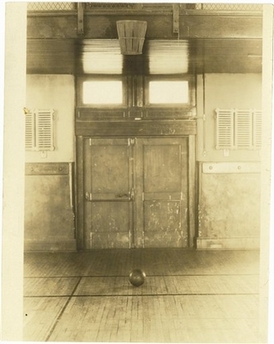When Dr. James Naismith invented the game of basketball in 1891 at Springfield College, he used peach baskets as the original baskets.
In the school’s indoor gymnasium, there was an elevated track running around the room. Onto it, Dr. Naismith nailed that legendary peach basket. The students then used a soccer ball to score points by tossing into the basket.
Initially, a ladder was used to retrieve the ball after a shot was made. Later a pole was utilized to poke the ball back out.
The original 13 rules of basketball discuss how the ball must settle in the basket to count as a point. Rule #7 even mentions the notion of goalkeeping, where an opponent is not allowed to touch the basket while the ball is in the process of settling into the basket.

This notion is confusing to us, however, considering we believe the first baskets were more than 10 feet high. Looking at the picture of the first basket, we cannot help but think the basket is almost 12 feet high, which we are fairly sure the first players could not reach.
Iron hoops and a hammock-style basket were introduced in 1893. Another decade passed, however, before the innovation of open-ended nets put an end to the practice of manually retrieving the ball from the basket each time a goal was scored.
The last major change was that a backboard was added. As mentioned, the original basket was nailed to the elevated track. The fencing around the track is clear in the image of the first basket. Spectators for early games would sit on the track level to watch, and could reach down and interrupt a shot into the basket. This is why the modern basketball hoop has a backboard. Today, that backboard serves a purpose in the game as a reflection board for shots. But when it was added, it was just to keep meddling fans out of the way.
